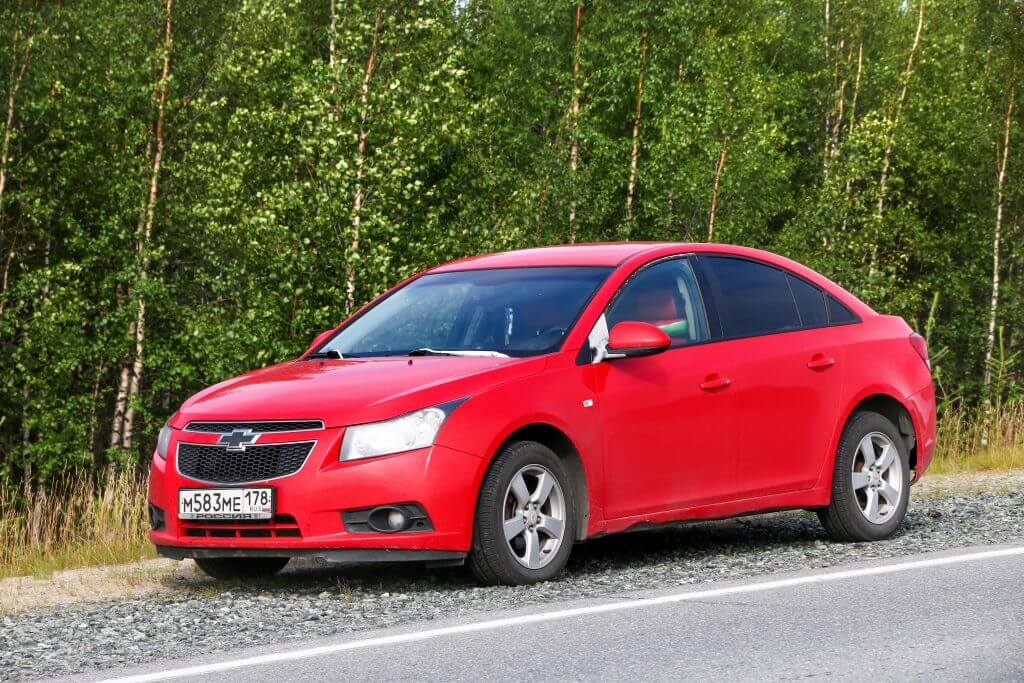The Chevrolet Cruze represented the automaker’s last attempt at making an economy car for the U.S. market. Replacing the sad Chevrolet Cobalt, the Cruze also marked one of the brand’s first vehicles to be released following General Motors’ 2009 bankruptcy.
But despite Chevy’s restart with this compact sedan, not every model year is a winner. That’s important to remember if you’re shopping for a used Cruze or already have one. To come up with a definitive list of model years worthy of a thumbs up or a thumbs down, we reviewed engine reliability data from the thousands of Chevrolet Cruzes using the FIXD App. We combined this information with what surveyed Cruze owners reported about dependability, trouble areas, and their overall experience with their vehicles. Further, we analyzed published sources that cover crash tests, fuel economy, and resale value.
Review this highlights chart and continue to learn more details about the best and worst Chevrolet Cruze model years.
| Best Years | Why? | Worst Years | Why? |
| 2015 |
Last year of the first generation, fewer recalls than in previous years |
2011-2014 |
First year of the first-generation (2011), low engine reliability scores, and an elevated chance of engine repairs |
| 2017-2019 |
Improved reliability scores, few recalls, and lower upkeep costs |
2016 |
First year of the second generation, high likelihood of expensive repairs |
Chevrolet Cruze Engine Reliability Score, Safety Ratings & MPG Year by Year
Our recommendations for the best Chevy Cruze years come from several key factors. This information includes engine reliability, government crash test results, fuel economy, and how market value stacks up against yearly maintenance and repair costs.
If you’re in the market for a car, take a look at our article on the USA’s most reliable and cheapest to repair vehicles in the U.S. Don’t get stuck with a lemon; use our data to help you shop.
Engine Reliability Score – Over The Years
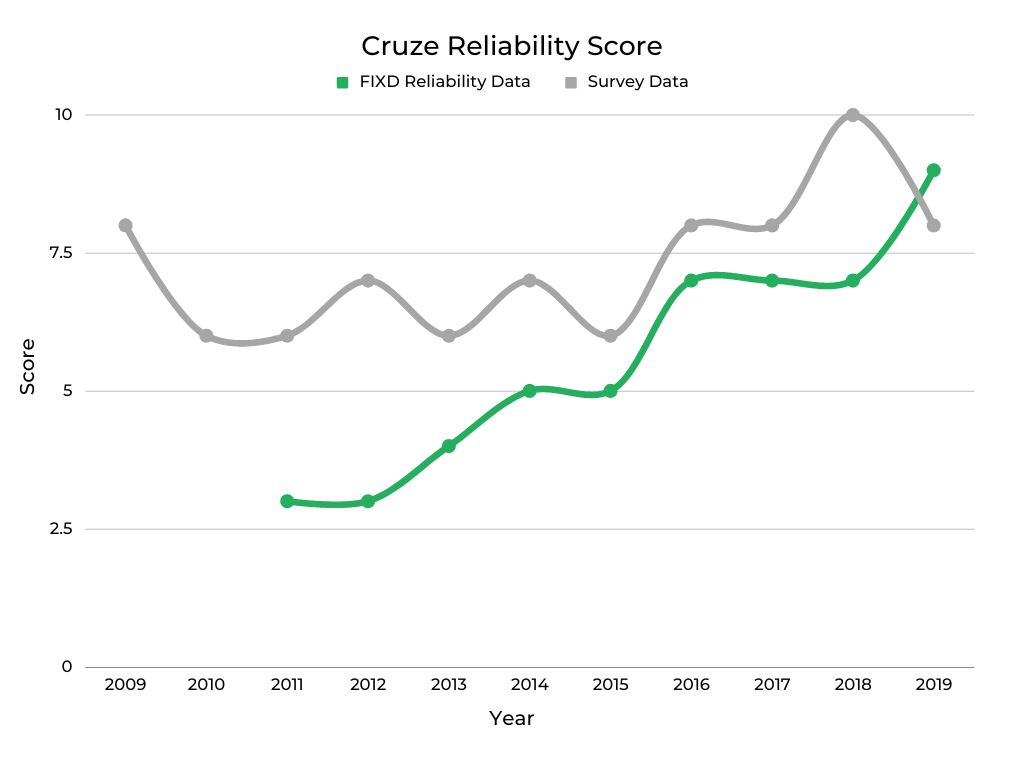
As a general trend, you’ll notice that Cruze’s FIXD Reliability Score (engine reliability) has improved over the years, which is a good thing. But, as we’ll cover later, there’s more to picking the best year for a car than just engine reliability.
The FIXD score comes from tracking the check engine lights that occur in Chevrolet Cruzes with the FIXD sensor. Meanwhile, the owner rating (the Owner Reliability Score) is based on the responses to a question covering how suitable their Cruze is for trips of varying lengths. For instance, basic point A to point B travel scores the lowest, while the car’s perceived readiness for longer drives (including cross-country road trips) ranks higher. For both scales, 10 is the highest, while 1 is the lowest (5 is average).
To learn more about the overall most common check engine lights for a Chevy Cruze, review our Chevrolet Check Engine Light article that details the most common causes for most Chevy model check engine lights.
Seeing low FIXD Reliability Scores (engine reliability) among older Cruzes isn’t surprising. Not only are these vehicles more than ten years old, but the Cruze is an economy car. In other words, Chevrolet sought to build the Cruze as cheaply as possible, so using durable components wasn’t necessarily the priority.
Albeit a bit perplexing, Cruze owners felt confident in taking their cars on trips beyond errand runs and commutes. This may or may not indicate higher reliability as owners may just expect to have more check engine lights because they own an older economy car.
NHTSA Safety Score – Over The Years
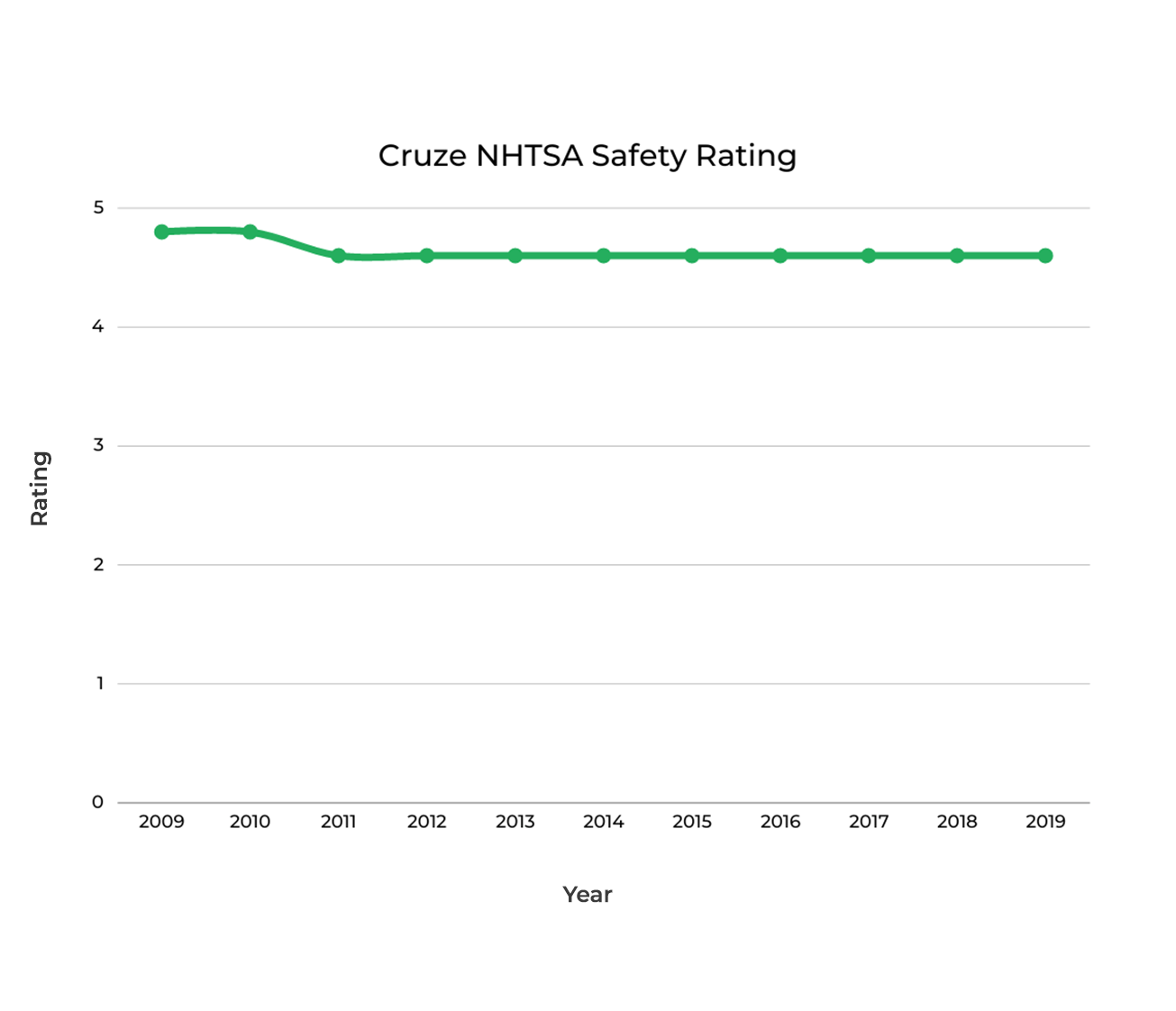
Despite the Cruze’s low-budget roots, you have to give Chevrolet credit for impressive crash test scores from the National Highway Transportation Safety Administration (NHTSA). A 4.6 (out of 5.0) or better ranking is praiseworthy. The results compare to a 4.0 for a 2011 Toyota Corolla and a 3.6 for a 2011 Nissan Sentra.
Regardless of the Cruze model year you’re considering or already own, there’s some confidence in knowing the car holds its own in government crash tests. Strong safety scores are important for keeping insurance costs low, an important factor, especially for a budget-conscious car shopper.
If you live in one of the states listed below, we can show you the cheapest vehicles to insure in yours.
What Used Cars Are the Cheapest To Insure In:
| What Used Cars Are the Cheapest To Insure In: |
|---|
| Ohio |
| North Carolina |
| Michigan |
| Georgia |
| Texas |
| New York |
| Illinois |
| Pennsylvania |
| California |
MPG – Over The Years
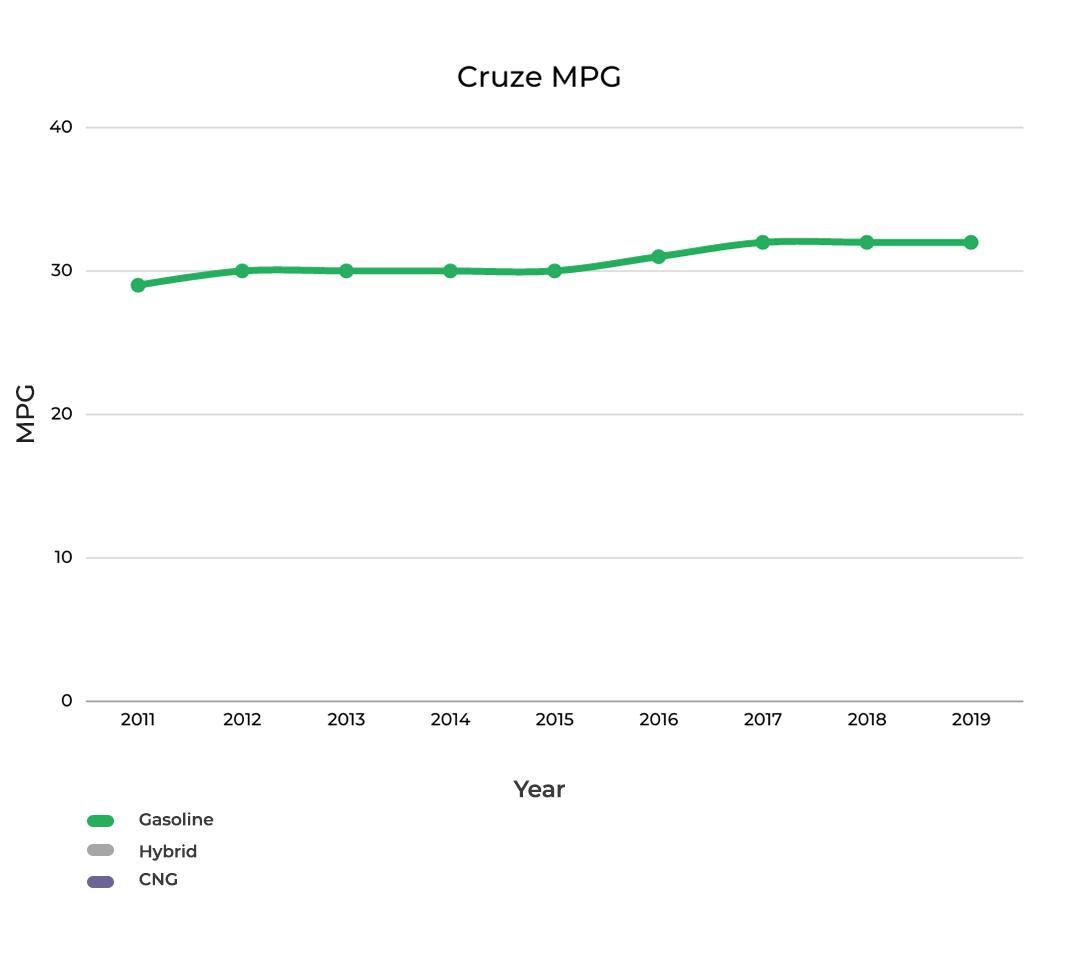
In another surprise, the Cruze’s average fuel economy is equal, if not better, than same-class competitors. Except for the debut year (2011), this Chevrolet model gets at least 30 mpg, and sometimes as much as 32 mpg. That translates into roughly 10% gas savings for the earliest Cruze model years (against competitors). Although, things even out as the competition catches up in the Cruze’s second generation (2016-2019).
Here’s a quick comparison.
| 2011 Model Year | 2019 Model Year | |
|---|---|---|
| Chevrolet Cruze | 29 mpg | 32 mpg |
| Nissan Sentra | 26 mpg | 29 mpg |
| Honda Civic | 27 mpg | 32 mpg |
| Toyota Corolla | 27 mpg | 33 mpg |
Current Market Value of All Chevrolet Cruze Years & Cost Per Year to Repair and Maintain Each
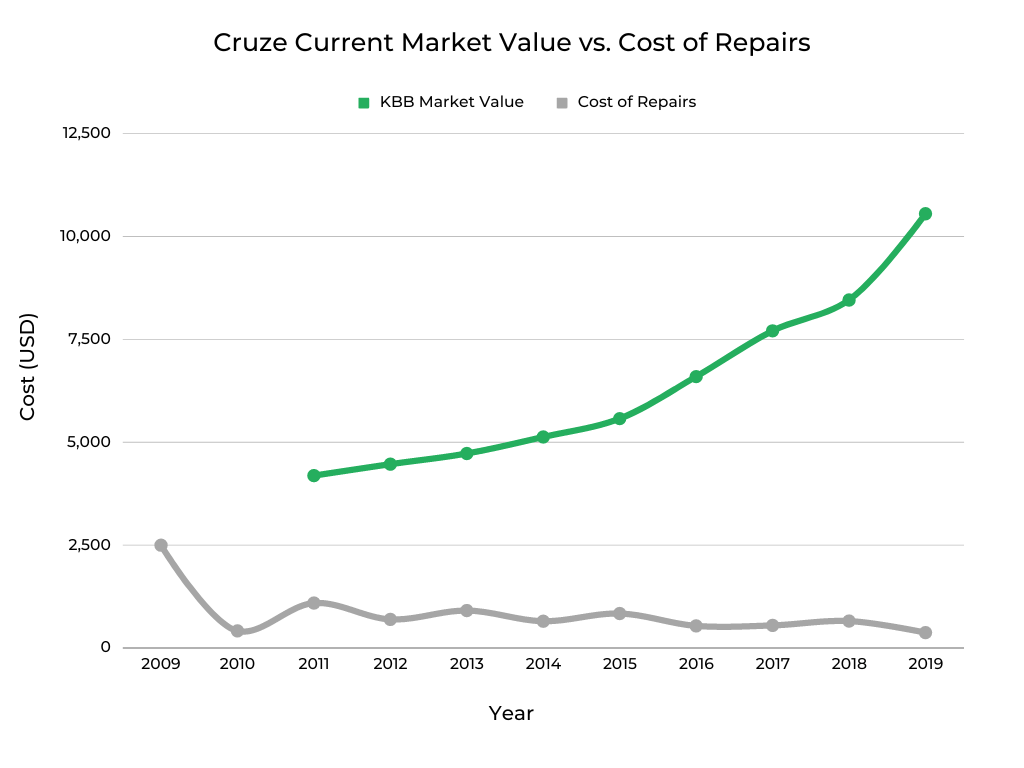
The average (of the nine model years) maintenance and repair costs were $701/year,. According to the owner surveys, Cruzes from 2011 ($1,094), 2013 ($911), and 2015 ($839) have higher than average repair costs for this model.
And despite these few annual repair budget “blips,” the KBB market value follows an upward trend as the model years get newer. Watching this is helpful, as high maintenance costs can negatively affect resale value. Yet, it’s important to note that high upkeep expenses are not unexpected with older cars because brakes and tires eventually need replacement on any car (as well as catalytic converters and a fair number of other things).
If you’d like to learn about this vehicle’s past depreciation rate & our projected depreciation rate based on that, check out: Chevrolet Cruze | Depreciation Rate & Curve Graphed.
When shopping for a used Chevrolet Cruze, it’s important to keep in mind that not all vehicles are cared for equally. To protect yourself from lemons, take along a FIXD Sensor on your test drive. FIXD connects to a free app on your smartphone to tell you more about the vehicle you’re checking out, including check engine lights and other hidden issues that the owner or dealership may be attempting to hide. Click here to learn more and get FIXD for only $19.99 (regular price $59)!
Important Features Timeline
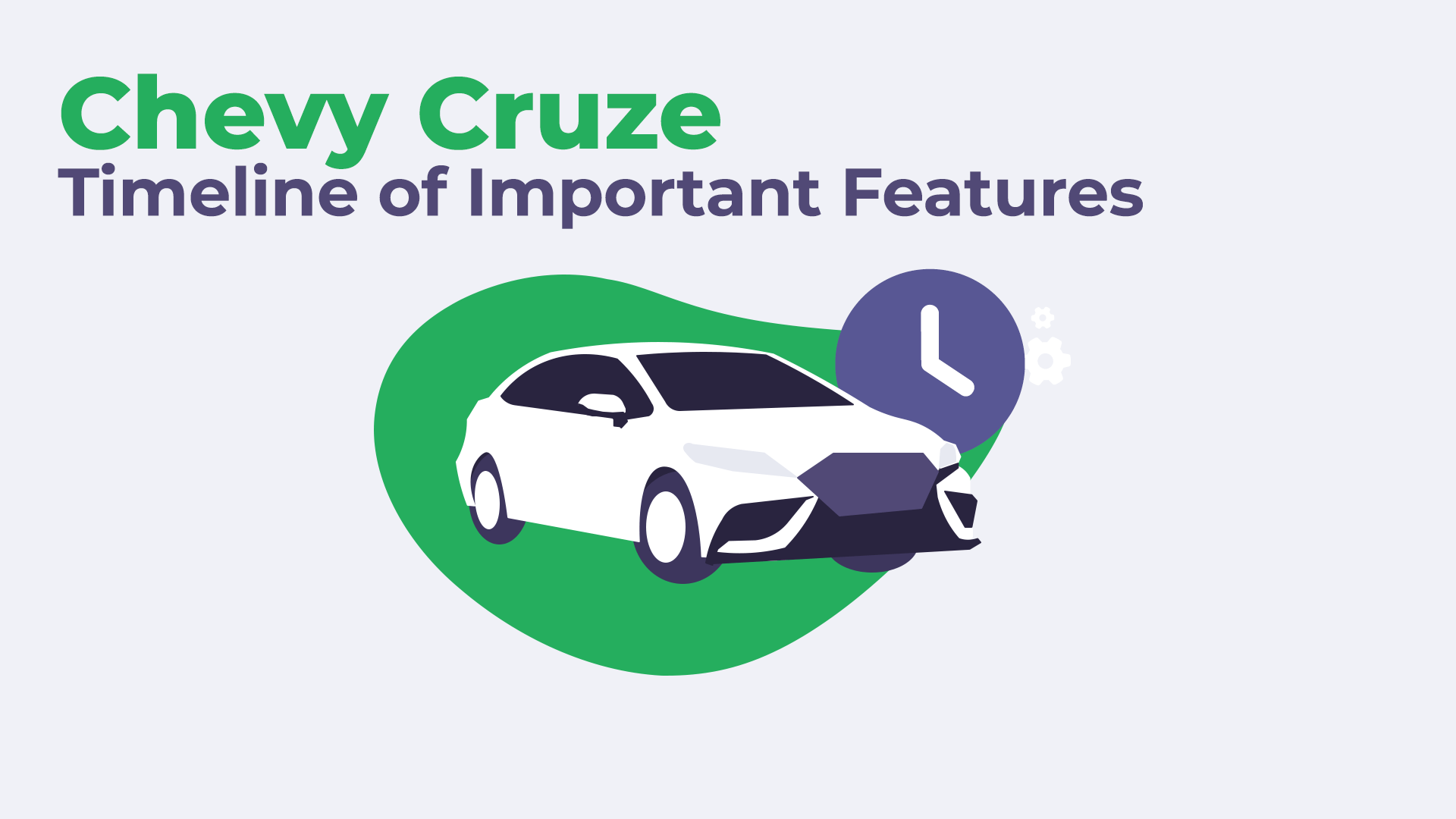
2011: The Cruze debuts in the U.S., taking over for the Cobalt
2012: Premium LTZ trim gets keyless entry and foglights
2013: Blind-spot monitoring and rear cross-traffic alert are optional on most trims
2014: A turbo diesel engine is available on the top trim
2015: Chevy makes minor styling updates, Siri Eyes-Free and upgraded OnStar are optional
2016: First year of the second-generation Cruze
2017: A five-door hatchback body style is added to the lineup
2018: Optional turbo diesel engine added to the hatchback’s option list
2019: Minor styling updates, last year of the Chevrolet Cruze
Best Years of the Chevrolet Cruze
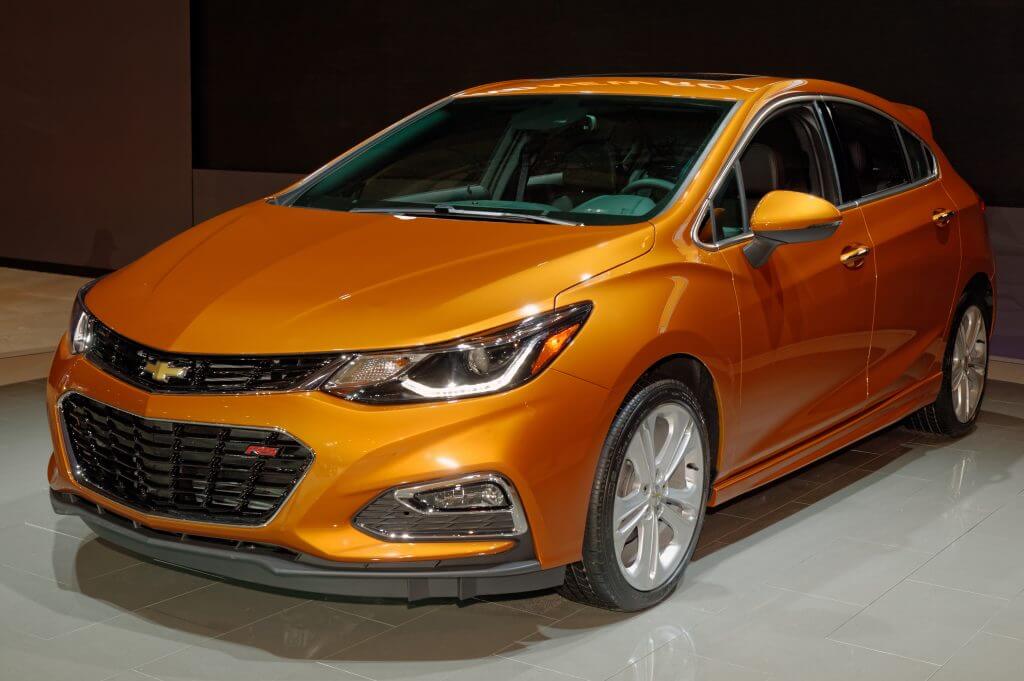
Our pick for the most-reliable Chevrolet Cruze model years was decided using FIXD Reliability Scores, owner surveys, crash test results, and fuel economy ratings. The choices also reflect likely diagnostic trouble code (DTC) codes and NHTSA recall information.
2017-2019 Chevrolet Cruze
FIXD Reliability Score: 7-9/10
Owner Reliability Score: 8-10/10
KBB Value: $7,708-$10,552
Fuel Economy: 32 mpg
Average Annual Maintenance/Repair: $375-$656
Average Likelihood of a $500+ Repair in 2022: 71%-100%
Safety Rating: 4.6/5
That old adage about getting what you pay for certainly rings true with the final three years (2017-2019) of the Chevrolet Cruze. Spend $10,000-$15,000, and you’re on target to get a car with solid reliability scores and lower annual upkeep. At least 32 mpg will help offset a more expensive vehicle, as it will lower yearly maintenance and repair expenses ($375-$656).
If the wallet allows, we suggest going for the 2019 Cruz because of a 9 (out of 10) FIXD Reliability Score and an Owner Reliability Score of 8. Plus, depending on the car, it may still be under Chevrolet’s five-year or 60,000-mile powertrain warranty (the five-year term starts on the day of delivery to the original owner).
Otherwise, a 2017-2018 Cruze gets you a 7 for FIXD Reliability Score and an Owner Reliability Score of 8 (2017) or 10 (2018). These numbers are encouraging.
The 2017-2019 models are also new enough that you might find options available under Chevy’s certified pre-owned (CPO) program, which adds six months or 6,000 miles of bumper-to-bumper coverage to any existing factory warranty. You will pay more for this extra protection.
The higher probability (71%-100%) of expensive repairs ($500+) is attributed chiefly to maintenance matters, like new brakes and tires. Except for a 28% chance of pricey engine repairs for the 2018 model year, these newer Cruzes have no individual trouble category (including engine, transmission, and electrical) with a greater than 9% likelihood of expensive service work. That’s the advantage of buying a newer used car.
It restates the obvious by saying that no car is perfect. As such, owners of 2017-2019 Cruze models may encounter several DTC codes. FIXD App data shows that P1101 can occur. It involves the car’s pollution control system, and fixes can require a new mass airflow sensor ($220-$320) or a replacement catalytic converter ($1,720-$2,400).
One issue to be aware of is that all Cruze model years are prone to vacuum leaks requiring the replacement of the valve covers. This is an expensive repair ranging from $2,532 to $3,046 and is associated with DTC code P1101.
Regardless of the Cruze model year you’re considering, have the car inspected and be sure to have the mechanic check for vacuum leaks relating to the valve cover problem.
Code P0172 may also appear, indicating an imbalance in the air-to-fuel mix. Repair costs range from as little as $100 to fix, but expect to pay $1,300 to $1,700 if the fuel pump needs to be replaced.
Other trouble codes known to occur include P0299, a faulty boost pressure sensor (which involves the turbocharger). This sensor typically costs $200 to $220 to replace. A bad catalytic converter can also generate this code and cost up to $2,400 for a replacement. Notably, Chevrolet provides an eight-year or 80,000-mile warranty on the emissions control system, which may cover the catalytic converter.
Another common DTC code for these Cruze years is P0420, a malfunctioning oxygen sensor (repairs: $275-$500), or it could also be the catalytic converter. Again, this problem may be covered by the emissions control warranty.
Owners of these Cruze models shared many likes and dislikes. Mainly, 18% appreciated the easy-to-use entertainment system, and 29% expressed dissatisfaction with the interior storage space. Given the smallish cabin, it’s almost expected for some owners to be left grumbling about where to store things.
One unexpected survey response did come up regarding vehicle longevity. 22% of owners felt their 2017-2019 Cruzes would last 200,000 miles, compared to 40% who believed their cars wouldn’t hit that benchmark. That’s a surprising disparity, considering these vehicles have an average of 77,000 miles on the odometer.
Most owners (56%) used their 2017-2019 Cruzes for long-distance driving and commuting, while the other 44% hauled family around in their Chevys.
The Cruze’s impressive crash test scores (4.6 out of 5.0) continue for the final years of this model. In addition, the 2017-2019 model years have the fewest recalls of any Cruze versions, with the most serious issue being the potential for a post-crash fuel leak.
2015 Chevrolet Cruze
FIXD Reliability Score: 5/10
Owner Reliability Score: 6/10
KBB Value: $5,575
Fuel Economy: 30 mpg
Average Annual Maintenance/Repair: $839
Average Likelihood of a $500+ Repair in 2022: 71%
Safety Rating: 4.6/5
If we could knight a car, we’d dub the 2015 Chevrolet Cruze the “least-best of the best model years to buy”. In other words, out of the best years we list in this section, if we had to put one on the chopping block, this would be the one that gets booted from the best years list.
So why even give the 2015 Cruze a thumbs up? Simple. If you’ve got less than $10,000 to spend on one of these Chevys, this is your only reasonable choice. Older models (which are covered below) will cost less but come with greater risks. And newer Cruzes will set you back even more.
Importantly, the KBB valuations you see here reflect average private-seller transactions. When buying a car through a dealer, expect to pay as much as 50% higher or more. And to further put Cruze prices into perspective, the average KBB valuation for a 2015 Toyota Corolla is $10,781 (compared to $5,575 for a Cruze from the same year).
Keeping an eye on the bank account gets easier thanks to the 2015 Cruze’s average fuel economy of 30 mpg. As mentioned, this fuel-sipping ability gives it a leg up over similar same-year cars from other companies.
A FIXD Reliability Score of 5 (out of 10) puts the 2015 Cruz squarely in the middle of the pack compared to the other model years. A near-identical Owner Reliability Score of 6 (out of 10) also parks this edition at the midpoint. That’s not great, but not terrible, either. You can call the 2015 Cruze a C-grade student.
A look at the most-common DTC codes for this model year of the Cruze uncovers P0599 (a faulty thermostat heater control circuit control) as the most likely culprit. Repair costs for this problem can run anywhere from $200 to $1,000.
P0171 is a known DTC code with the 2015 Cruze. And like P0172, it signals an incorrect air-to-fuel ratio mix. This can be caused by many factors, like a bad mass airflow (MAF) sensor (repair: $220-$320), a vacuum leak (repair: $100-$200), or a malfunctioning PCV valve (repair: $76-$92). As with the 2017-2019 models, P1101 is among the more frequent DTC codes for the 2015 Cruze.
It’s important to remember that bad valve covers (along with pricey repairs) are always a possibility if code P0171 or P1101 arises with a Chevy Cruze.
Average annual maintenance and repairs costs of $839 burden this Cruze year with above-average upkeep expenses, but that’s hardly surprising for a car that’s getting on in age. A 29% chance of an expensive engine repair (above $500) isn’t encouraging, but it’s lower than older Cruze model years which have up to a 34% possibility of a similar problem.
A dive into what owners thought about their 2015 Cruzes revealed that 14% felt their rides could reach 200,000 miles (105,000 miles is the average mileage among survey respondents). This contrasts with the 30% who felt their cars wouldn’t last that long.
19% of owners reported great driver visibility as the most preferred feature of the 2015 Cruze. Unsurprisingly, most (69%) of 2015 Cruze owners use their cars as family vehicles. The remaining 31% cite using their Chevys for commutes and long trips.
Like other Cruze model years, the 2015 edition gets high marks for solid crash scores (4.6 out of 5.0) in NHTSA testing. The government reports the 2015 Cruze underwent four recalls, which can be explored on the NHTSA website. The most severe issues involved a defective parking brake cable and troublesome steering gear.
The Worst Years of the Chevrolet Cruze
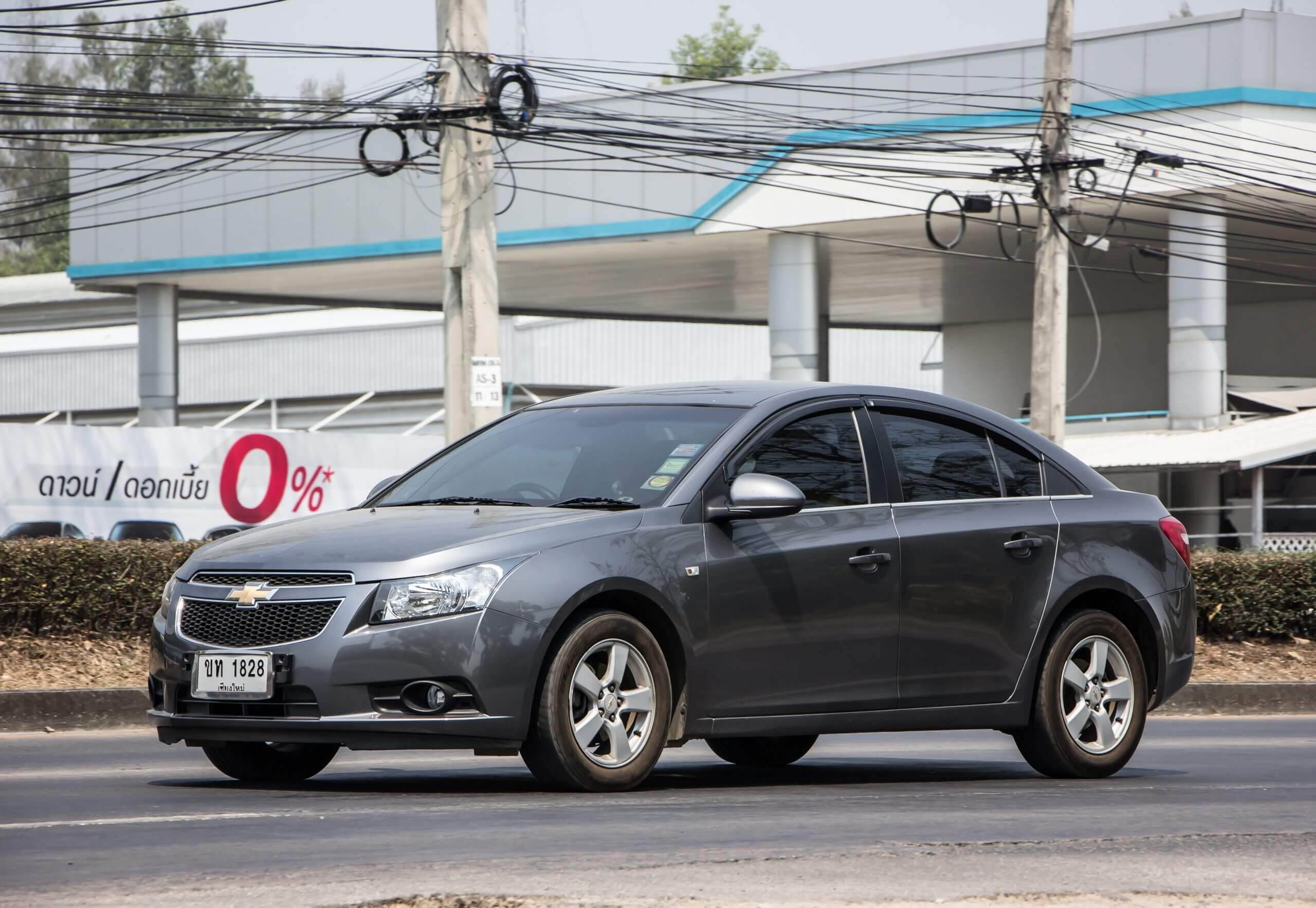
Like with most cars, there are some model years to avoid. And the Chevrolet Cruze is no exception. The FIXD Reliability Score, owner feedback, and other crucial indicators point to several examples to avoid. This information can also be helpful if you own one of these unfortunate Cruze model years.
2011-2014 Chevrolet Cruze
FIXD Reliability Score: 3-5/10
Owner Reliability Score: 6-7/10
KBB Value: $4,190-$5,129
Fuel Economy: 29-30 mpg
Average Annual Maintenance/Repair: $652-$1,094
Average Likelihood of a $500+ Repair in 2022: 66%-68%
Safety Rating: 4.6-4.8/5
For simplicity, we’ve grouped together the first four years (2011-2014) of the Chevrolet Cruze as ones to avoid at all costs. For one, we always advise skipping the first year or two of an all-new model. A FIXD Reliability Score of 3 (2011-2012) bears this out, although owners are more generous, giving their Cruzes a reliability grade of 6 or 7.
A further dive into the FIXD App data reveals some cautionary results, including very high annual repair expenses of $1,094 (2011) and $911 (2013). What’s particularly eye-opening is that every model year in this group has at least a 33% chance of expensive ($500+) engine repairs. And if that isn’t bad enough, the 2011 and 2013 Cruze have an elevated likelihood (27% and 18%, respectively) of costly transmission work. That’s a higher percentage than any other Cruze model year.
The lower KBB values may be tempting to a budget-minded used car shopper, but getting a “deal” will be a mistake if you later get hit with a multi-thousand-dollar repair bill.
Many DTC codes frequently affecting later Cruze model years can surface with the 2011-2014 versions. So, be prepared for P0171, P1101, P0420, and P0299. As with the Cruze models on our best years list, P1101 can be accompanied by the need to replace the valve covers.
In addition, P0597, a faulty thermostat, can appear. At least this isn’t too expensive to fix at the cost of $140 to $300.
Do the 2011-2014 Cruze models have any shining graces? Yes, a fuel economy rating of 29 to 30 mpg is noteworthy for a decade-old car, and NHTSA crash test scores are exceptional. But neither of these positive characteristics outweighs the high potential for an unreliable car ownership experience.
2016 Chevrolet Cruze

FIXD Reliability Score: 7/10
Owner Reliability Score: 8/10
KBB Value: $6,595
Fuel Economy: 29-30 mpg
Average Annual Maintenance/Repair: $538
Average Likelihood of a $500+ Repair in 2022: 73%
Safety Rating: 4.6/5
On the surface, the first year of the second-generation Chevrolet Cruze doesn’t look half bad. But there’s that first year of a new model generation thing again. And particularly because the Cruze has an all-new engine, we suggest leaving the gremlins and teething pains to someone else.
However, there’s more to staying away from the 2016 Cruze than anti-first-year bias. Primarily, there’s a 73% chance of a repair requiring an outlay of $500 or more. The numbers further break this down into a 27% possibility of engine work and a 17% chance of a transmission repair. While the odds say these issues are less likely to happen, do you really want to risk this? Instead, you can go for a 2015 Cruze (and spend less) or cough up more for a newer model (and breathe easier).
The owner survey reported that the average 2016 Cruze had about 108,000 miles. Issues like engine and transmission problems shouldn’t be a worry for a seven-year-old vehicle with this amount of miles.
Of course, the 2016 Chevy Cruze isn’t exempt from its share of DTC codes. Most frequently, the Cruze-familiar P1101 and P0299 are well-known to this model year. As we detailed, P1101 and replacing the valve covers (repair: $2,532 to $3,046) often go hand in hand.
In addition, P0101, a malfunctioning mass airflow (MAF) circuit, is known to occur. Repairs could be as basic as getting a new air filter ($50-$70) or replacing the MAF sensor ($220-$320). In extreme cases, the catalytic converter might need to get swapped out (up to $2,400). Again, if the Chevrolet emissions system warranty is still valid on a 2016 Cruze, it’s worthwhile to see if a MAF-related repair is covered.
To add insult to injury, 18% of 2016 Cruze owners consider their cars expensive to repair. On its own, that number may not be significant. However, that’s higher than any other Cruze model year. Perceptions really matter when it hits the wallet.
Is there anything nice to say about the 2016 Cruze beyond good gas mileage and high NHTSA crash test scores? If you want to make lemonade out of lemons, the 2016 model has low annual upkeep expenses ($538). Plus, 19% of surveyed owners thought positively of the car’s driver visibility and sound system. Yet, these positives hardly overcome the negatives of the 2016 Cruze.
Frequently Asked Questions: The Best and Worst Years of the Chevrolet Cruze
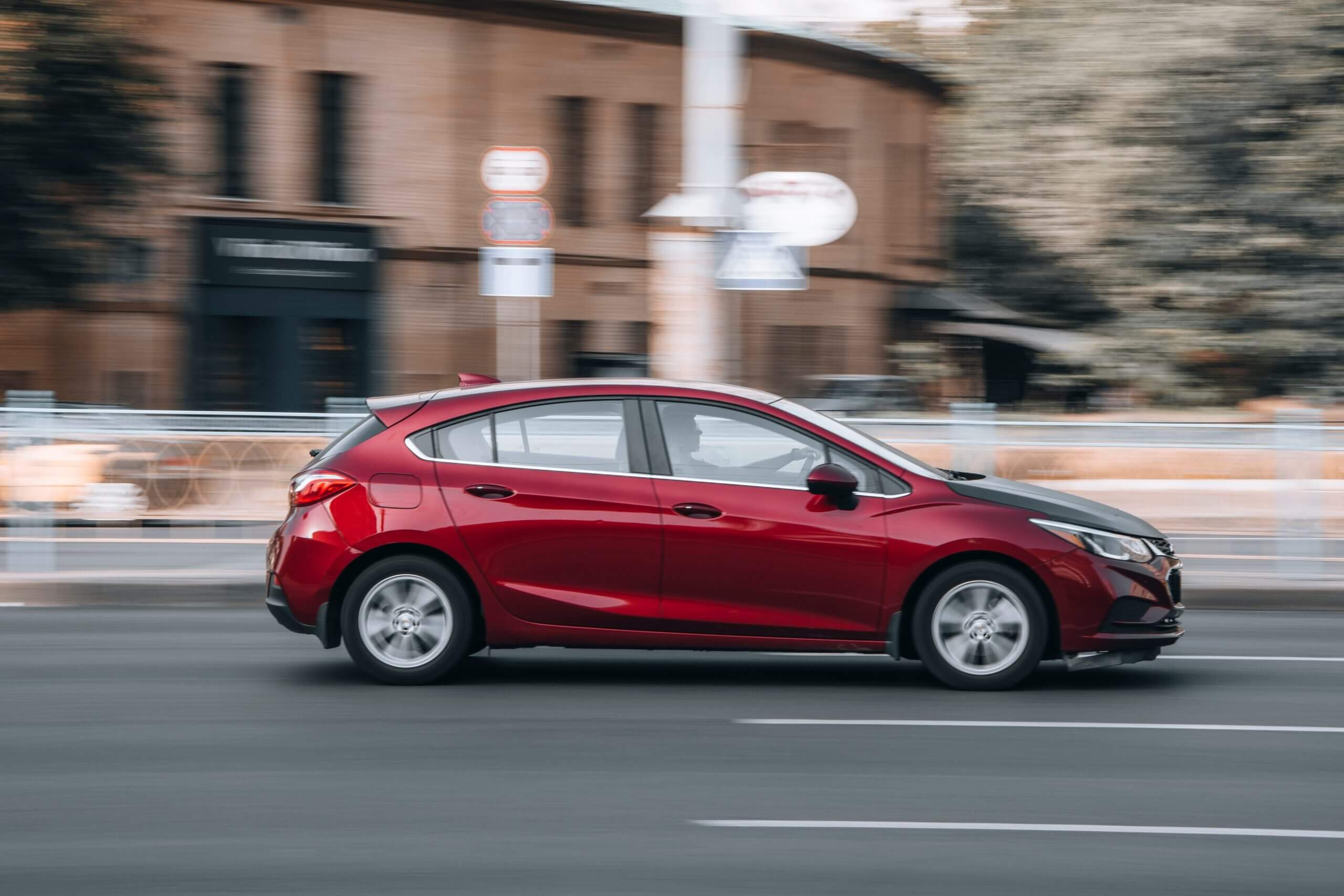
What years of the Chevy Cruz have engine and/or transmission problems?
Several Cruze model years are no strangers to engine and transmission issues. The 2011 through 2014 model years are terrible, with at least a 33% chance of engine troubles. Just stay away from these models, as we mentioned earlier. In addition, there’s a 27% probability of a 2011 Cruze needing transmission work. Likewise, the 2016 Cruze gets flagged with a 27% likelihood of engine repairs.
It’s important to note that two models on our best list, the 2015 and 2018, are cited with a 29% probability of engine repairs. This means that other characteristics (as covered) still make these years a worthwhile consideration. That said, every used car purchase should include a thorough inspection by a professional mechanic before signing the paperwork.
What is considered high mileage for a Chevrolet Cruze?
Because of factors like usage and maintenance, high mileage can have different definitions for the Chevy Cruze. For instance, a well-maintained example with 150,000 miles of mostly highway mileage is likely to hold up better than an 80,000-mile Cruze that has been through the rigors of city driving and missed maintenance work.
Asking Cruze owners yields conflicting results about vehicle longevity. 19% feel their cars will reach 200,000 miles, while 33% say otherwise.
What other vehicles should I consider?
While four-door passenger cars are few and far between in new car showrooms, there are other options if you’re considering a pre-owned Chevy. Next up in capacity is the mid-size Chevrolet Malibu sedan, the last sedan that Chevy still sells new. For more space, the full-sized Chevrolet Impala offers generous leg and trunk room. 2020 was the final year for the Impala.
For those looking outside the Chevy family, there are numerous compact cars to consider. Options include the Toyota Corolla, Honda Civic, Mazda 3, Nissan Sentra, Hyundai Elantra, Ford Focus, and Kia Forte.
A Note About Data and Information Sources
This article details the Chevrolet Cruze’s reliability; here’s what we used for our assumptions and recommendations.
FIXD Reliability Score & Data: Engine reliability information is captured via the FIXD App.
The FIXD Reliability Score is calculated using the number of DTCs per year, weighted by mileage. This is then turned into a scale of 1-10 for easy graphing.
This is an objective score.
Owner Reliability Score & Data: This data results from surveying Chevrolet Cruze owners who use FIXD.
The Owner Reliability Score comes straight from owners of the Chevrolet Cruze.
This is a subjective score.
To determine the Owner Reliability Score, we ask each car owner:
How reliable would you say your Chevrolet Cruze is?
- Just point A to point B driving
- A Daily Commuter
- Good for a 100-mile road trip
- Good for a 500-mile road trip
- I could take a cross-country road trip, no problem
From here, we translate their answers into the Owner Reliability Score:
- = 2
- = 4
- = 6
- = 8
- = 10
Keep in mind owners may think their car is more or less reliable than it actually is.
One potential problem is that people often buy the same make or model they are used to when they go car shopping, just a newer year.
Ford, for instance, has several consumer loyalty awards for the Ford F-Series, Ford Mustang, and Ford Expedition.
Car owners may be so loyal to the make or model they currently own that they would have trouble accurately comparing their cars’ reliability to others.
It’s for this reason that we intentionally ask car owners a question that is relative to mileage rather than relative to other cars.
Still, be mindful of the accuracy of these Owner Reliability Scores; people’s perceptions and unconscious blind spots can skew data.
We suggest looking at the FIXD Reliability Score and the Owner Reliability Score for this reason.
- KBB Value: Average private-seller valuations as supplied by Kelley Blue Book (KBB), based on a {make} {model} with typical mileage for that respective model year.
- Fuel Economy: Mileage-per-gallon estimates according to the EPA MPG on Fueleconomy.gov
- Annual Maintenance/Repair: Upkeep expenses as reported by surveyed Ford Chevrolet Cruze owners
- Safety Rating: Crash test data collected and reported by NHTSA. We average all ratings for each year to come up with a simplified, average safety score. This makes it easier to look at on a graph.
What owners of the Chevrolet Cruze like to use their cars for:
Percent based x/5-star: 0-10% = 1, 11-20% = 2, 21-30% = 3, 31-40% = 4, 41%+ = 5
| Frequent Use Categories: | How Useful? (Out of 5 Stars) |
| Family Vehicle | ***** |
| Lots of Driving (travel/long commute) | ***** |
| Hauling/Towing | * |
| Office on Wheels | * |
| Sport/Fast Driving | * |
| Luxurious Driving | * |
| Outdoor/Off-Road | * |
References
- Chevrolet Cruze model-specific information, edmunds.com (various dates). Retrieved April 5, 2023, from https://www.edmunds.com/
- Model-specific recall information as per the National Highway Transportation Safety Administration. Retrieved April 5, 2023, from https://www.nhtsa.gov/recalls
- Chevrolet Limited Warranty document (2017). Retrieved April 6, 2023, from https://tinyurl.com/5n6m7kp4

Dave Goldberg is an automotive journalist and lifelong car fanatic. He writes for numerous enthusiast and business outlets and is an ongoing contributor to HotCars.com, one of the most popular car culture websites. When he’s not writing or driving, Dave is either under a hood or asleep. His credentials include a BA in Journalism from The George Washington University.

